

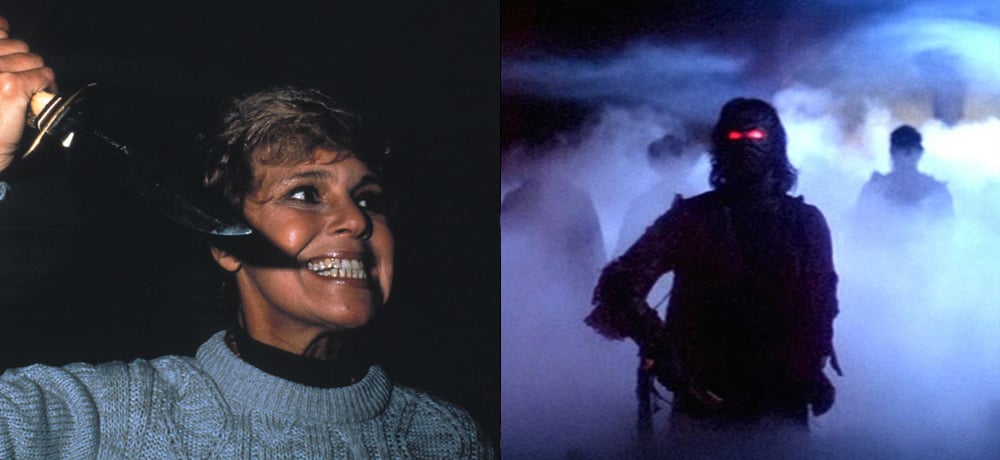
For the last two weeks, we here at Daily Dead have been doing our best to laud and commemorate the 40th anniversaries of all the great horror and science fiction films that were released throughout the year 1980. And as we get set to wrap up our extensive coverage today and tomorrow, we thought it might be fun to reach out to some fantastic voices in the realm of genre entertainment.
So, for today’s Class of 1980 celebration, we will be featuring the likes of Kelli Maroney, Bill Moseley, Adrian Roe, Ben Rock, Axelle Carolyn, Drew McWeeny, April Wolfe, Graham Skipper, and Brian Collins all discussing a variety of notable horror and sci-fi movies from 1980, including Dressed to Kill, The Changeling, The Visitor, The Apple, Friday the 13th, The Boogeyman, Mad Max, Battle Beyond the Stars, and The Fog.
And be sure to head back tomorrow for part two of our final Class of 1980 celebration, featuring so many more amazing folks you’ll definitely want to hear from as well.
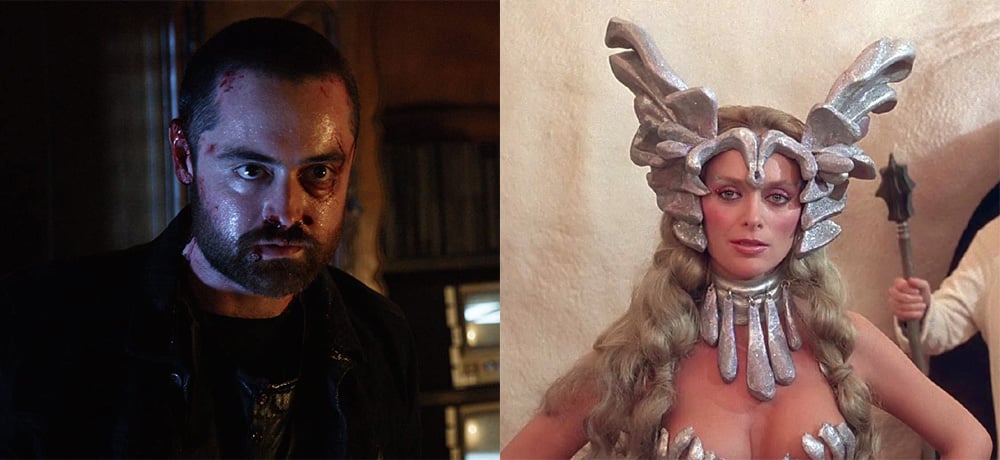
Graham Skipper (Writer, Director, Producer, Actor)/Battle Beyond the Stars
I first heard about Battle Beyond The Stars as “Roger Corman’s Star Wars rip-off.” To dumb it down to just that, however, is doing a vast disservice to a flawed, but extremely well-made enigma of a movie that charms me every time I see it. It’s a mixtape of Star Wars, ’60s-era Star Trek, Alien, Battlestar Galactica, and of course, Seven Samurai and The Magnificent Seven, full of surprisingly good performances and art direction by “talented newcomer” Jim Cameron, and a bombastic score by also-newcomer James Horner, and all directed by a legend of animation. In short: this movie rocks.
Battle Beyond The Stars is a remake of The Magnificent Seven, itself a remake of Akira Kurosawa’s Seven Samurai. It tells about the peaceful planet Akir (get it?) that is being invaded by a formidable evil race known as the Malmori (led by a one-armed, scarred John Saxon absolutely devouring the scenery). The Akir then reach out across the galaxy to find mercenaries who will come to their aid. You know the drill.
The thing that makes this movie so special, though, is its inconsistencies. The model work of the ships is absolutely on par with everything Star Wars did (thanks to the aforementioned Jim Cameron, who also met Bill Paxton on this set, as Paxton helped build them), the acting across the board is heartfelt and affecting, and the score huge and gorgeous, giving us a taste of what Horner would do throughout his career after this. But then you have an inherent cheesiness to the whole endeavor, some truly silly moments that don’t quite work, and some costume design that reads less like sci-fi and more like a high school musical. Battle Beyond The Stars is childlike and full of ridiculous set pieces and characters that children would love, but it’s butted up against harrowing graphic violence and overt sexual references.
The whole thing shouldn’t work at all, but somehow it does. And what Corman always did so well was put together a team of talented unknowns to create something that is way better than it has any right to be. And all of this for a budget 1/5th that of Star Wars! It’s a pretty remarkable achievement, and while yes, Star Wars may be a better movie, I feel that Battle Beyond The Stars has more heart. You can see the strings (and occasionally some crew members), and feel the sweat that went into this movie… and that makes it all the more special. So, don’t just think of it as “Roger Corman’s Star Wars rip-off.” It’s “Roger Corman’s sci-fi masterpiece.”
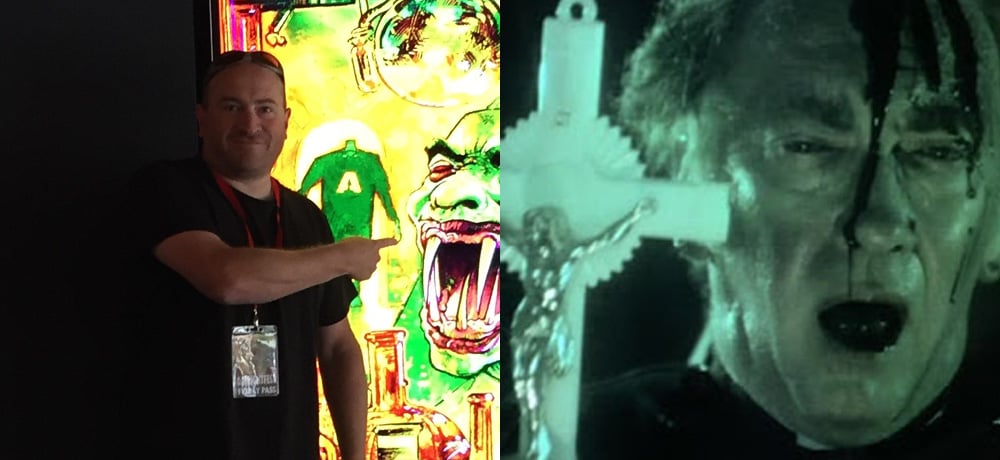
Adrian Roe (Author)/The Boogeyman
It would probably be a fair assessment to consider 1980 as the very peak of the “classical slasher” film. This early post-Halloween era would deliver some of the most notable and memorable of entries, creating a legacy that is still very much with us today. While it would be easy to simply sing the praises of some of the most critically acclaimed and popular slashers of the time, there is a little gem hidden under the noisy celebration and recognition of the more obvious titles that doesn’t always seem to receive the attention it deserves.
On the surface, it would be easy to dismiss Ulli Lommel’s The Boogeyman (1980) as just another cynical piece of creative exploitation, a film that simply looks to cash in and use the familiar tropes that seemed to work so well during this period, and to be fair, this criticism wouldn’t be entirely unjustified.
The irony, however, is that these tropes are employed so effectively by Lommel that we are left with a slasher film that manages to successfully blend various subgenres into its narrative, leaving us with a highly entertaining and fascinating piece of filmmaking. The sleazy and sordid opening that culminates in the brutal stabbing of a man committed by a young boy quickly gives the viewer a good indication that The Boogeyman will offer horror fans something of note. The well-paced story then follows the boy, Willy, and his sister, Lacey, into adulthood, as they attempt to come to terms with their horrific past. While Willy remains mute since his childhood trauma, Lacey is married with a young son, and it isn’t long until they are drawn into this visceral nightmare. The film then offers us a supernatural shift as Lacey and Willy appear to have visions of Willy’s victim, who is trapped within mirrors and able to kill various unsuspecting victims using his unseen powers.
The third prolific element of this multi-layered slasher is possession, as Lacey becomes possessed by the very man her brother killed all those years ago. The climax of The Boogeyman doesn’t disappoint, as Lommel delivers some impressive visuals that will see a priest having to battle the possessed Lacey, in an attempt to free her tortured soul. The creative use of lighting, mirrors, and plenty of blood will leave even the most demanding of slasher fans satisfied with Lommel’s efforts. Beyond the obvious visual attributes, The Boogeyman also surprises with its ability to charm the viewer. The film draws a lot of strength from its characters, as we enter the world of a close family unit, only to see it battling with itself from the inside. This empathy certainly adds weight to the struggle unfolding before our eyes. You identify with Lommel’s characters, you care. The film also boasts a haunting soundtrack, adding to the sense of an unseen danger that remains present throughout.
Yes, Lommel borrows heavily from films like The Exorcist (1973), Halloween (1978), and various other genres pieces, but in doing so manages to create a vision that very much holds its own within the genre. Banned in the UK for many years and labeled as one of the infamous “video nasties” of the time, The Boogeyman has managed to secure a certain amount of notoriety and remains a cult favorite for many.
The Boogeyman may be criticized for not being wholly original, but it certainly delivers a little bit of everything that makes this genre so special—an achievement in itself that cannot be ignored.

Axelle Carolyn (Filmmaker)/The Fog
Ghost stories appeal to me more than any other genre. There’s something universal, almost primal about them. So it‘s perhaps not completely surprising that I prefer The Fog to the John Carpenter classics on either side of it, Halloween and Escape From New York.
Can you imagine how terrifying it must have been to follow up the most successful indie movie to date? In a way, The Fog is almost the anti-Halloween: it follows different points of view and gives its villains clear motivation; they may also be “shapes,” but they were human beings; unfortunates who were robbed and killed.
There’s such scope to their mythology. Antonio Bay, funded with stolen money, is pretty much a metaphor for America itself. There’s an elegance to this movie, and a unique beauty, with Dean Cundey’s cinematography and its incredible locations. Halloween is a fun ride, but The Fog shows a lighter touch, with little gore and lots of atmosphere. And yet it’s so effective.
One night during a stay in South Africa for a film shoot, a bank of bright fog appeared and moved slowly towards the bay windows of the waterfront apartment I stayed at. I remember thinking, “If someone knocks at the door now, I’ll die of a heart attack.”

Drew McWeeny (Film Writer, Author, Screenwriter)/Mad Max
While the Mad Max series overall is known primarily for high-octane action, and rightfully so, the original film feels very much to me like a horror movie when watched today.
You can tell that Miller is already thinking about how to shoot action in a way that elevates it and makes it more viscerally involving, but the primary thing this film runs on is dread. Beautifully shot by David Eggby, the film throbs with menace in every corner. Things are wobbling out of control as the film opens, even though the world hasn’t officially ended. Max Rockatansky is a cop who frequently battles psychotic motorcycle punks like the Nightrider or the Toecutter. Max and his partner Goose try to stop them, but the system is collapsing, and all they do is accelerate the fight. Max tries to escape after the punks burn Goose alive, but the gang hunts him. I think of that section of the film as terrifying. Nothing Max does helps. It all feels awful and inevitable. Once they do finally destroy Max’s family and he breaks, the film shifts into a different gear, and Max becomes the avenging angel, a force of pure rage and violence, and the final sequence is thrilling, yes, but also terrifying in the raw intensity with which Max unleashes. Even the final fate of the final guy Max hunts down is awful. Satisfying, but awful.
Mel Gibson’s work here is almost silent movie acting. So much of it is about body language and his face as he drives and reacts, and he’s got a great opponent in the form of Hugh Keays-Byrne, who returned to the series later as the great Immortan Joe. Here, his Toecutter is disturbing and genuinely seems to delight in the misery he rains down on Max. That’s why I think of the first film as feeling like it’s part of a different genre than Road Warrior or Thunderdome or the pure nitro action bliss of Fury Road. This feels like the same kind of fine line between genres as Escape From New York. This is the film about what breaks poor Max, what drives him mad, and that feels like pure existential horror with no way out when you realize the world itself seems to break as a result of what happens to Max here.
It’s like the shift in tone between Evil Dead and Evil Dead 2. I can’t tell you which one I prefer; I can just tell you that they work in very different ways, and watching this, I wish Miller had made a few pure horror features during his career, although I’m not sure, seeing how great he is at action thrills, that the general audience could survive.

April Wolfe (Screenwriter, Podcaster)/The Apple
The first time I saw The Apple was at a midnight showing at the Nuart on one of those rare nights when it replaced The Rocky Horror Picture Show. A friend had invited me and my then-boyfriend, and I don’t think we were prepared for the horde of diehards wearing shiny triangle stickers on their faces (BIM marks), asymmetrical bangles, crimped side ponies, and silver lamé shorts.
With such a vague film title, there was no way we could know that we were in store for a speed-freak disco circa 1994 based equally upon the Eurovision song contest and the Biblical story of Genesis—Eve’s temptation of evil—ending with a literal Cadillac in the sky delivering hippies unto a better world as God’s chosen children. There’s so much to disentangle about this film, like is it maybe a little racist? I’d say probably. The white bread, clean Canadians are, after all, the symbol of purity and redemption. But for my money, evil wins every time.
Catherine Mary Stewart’s performance of the song “Speed” as Devil-possessed Bibi is imprinted on my brain. (I’ve wanted to pay someone to make me her costume for 15 years; forgive me, I am very lazy.) Vladek Sheybal and Ray Shell as Boogaloo and Shake (our stand-in for the Devil and his Snake) make me tingle with delight; they’re both awkward and oddly mechanical and yet fully committed to their sinister debauchery, setting a manic, off-the-rails tone.
It’s one of the first films I bought on DVD, and I’ve forced God knows how many people into an impromptu viewing of it late into the night, after drinks and when there’s nothing left to say. Strangely, The Apple does offer up one of the better—and sillier—critiques of the breakneck pace of the United States in late-stage capitalism. As Bibi sings: “America, the home of the brave, is popping pills to keep up the pace.” God bless The Apple.
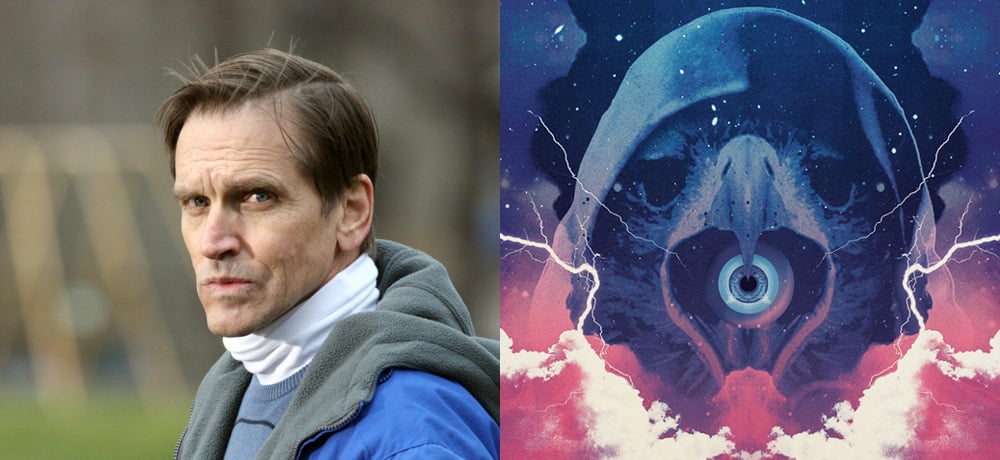
Bill Moseley (Actor, Musician)/The Visitor
There’s no way for me to describe the Italian horror/sci-fi movie, The Visitor, in just a few short sentences. Plot summary easy enough for IMDb.com: “The soul of a young girl with telekinetic powers becomes the prize in a fight between the forces of God and the Devil,” but it’s hard to follow said plot when director Guilio Paradisi keeps distracting us with the likes of Franco Nero, John Huston (yes, THE John Huston), Mel Ferrer, Lance Henriksen, Glenn Ford, Shelly Winters, and Sam fuckin’ Peckinpah! I know, I know…
I watched The Visitor with daughter Marion Moseley, 21 and a recent UCLA grad, on one of those endless quarantine nights just to give the faithful reader two perspectives on this dusky jewel, which neither of us had ever seen or heard of before. It starts off with John Huston in an otherworldly desert facing off with a presumably female figure wrapped head-to-toe in dark robes as an ominous yellow sand/snowstorm approaches (courtesy of one of my favorite old school SFX, the cloud tank!). Then, a wind machine is blowing foam (?) into the faces of poor JH and the figure. John Huston just winces heroically; the Figure is wind-peeled and revealed to be a young girl (12, maybe 13?) who smiles an evil smile.
Then, we cut to an interior of what appears to be a large, Ancient Greek-style classroom, very white and bright, with plenty of pillows and trickling fountains, filled with quiet, toga-robed bald children listening attentively to a piercingly blue-eyed Franco Nero (yes, THE…), in long blonde Jesus wig, to expound upon the history of an evil character named Zatteen, who was almost destroyed by the forces of good, but somehow managed to escape to… you guessed it, planet Earth (Atlanta, specifically) where he’s inhabited the body of a little girl. What to do? Why, send in John Huston of course!
Okay, so far plot’s a little rococo, but Marion and I are sticking with it. We keep doing time checks with the pause button—at this point there’s probably an hour and twenty minutes to go. Yikes!
So it’s John Huston and his better angels (who camp out on top of an abandoned building in good old Hot ’Lanta) versus the evil little girl, Katy Collins. Katy’s single mother, Barbara, is being wooed by Satanist-about-town Lance Henriksen, who needs to knock her up to produce a male offspring who will then mate with his sister to create the evil Zatteen in the flesh. But once-divorced Babs is gun-shy about walking the aisle again, so evil Katy “accidentally” shoots mom in the back with her own birthday gift that was wrapped as a wind-up talking bird, but somehow turns into a loaded .45.
So, Barbara is now in a wheelchair—did I mention that mother and daughter live in an absurdly expensive mansion and that Katy has a pet sparrow hawk that attacks investigating detective Glenn Ford, pecks out his eyes on the highway, and causes his car to crash and burst into flames? No? Well, they do, and she does, and Shelly Winters is the new housekeeper with a penchant for astrology and tough love when it comes to impudent Katy. A few slaps to the lippy kid’s mug when mommy’s not around gets evil Katy’s attention!
Oh, and then John Huston shows up as the babysitter (sure, a 75-year-old man sent by the agency to sit a 13-year-old girl?!) on the very night that Lance tries once more to bed the now-crippled Barbara. When Lance fails, the Atlanta Satanists, with Katy’s gleeful support, kidnap Babs and impregnate her in the back of a semi. Not a problem. The mom gets her ex-husband, a world-weary doctor played by Sam Peckinpah, to perform an abortion, thus foiling evil’s master plan. Whew! (Is that still legal in Georgia?)
In the end, all that’s left for Katy and Lance is revenge, and they attack poor Barbara with the sparrow hawk and then try to behead her by tying fishing line around her neck and sending her down the wheelchair stair lift! Thank God John Huston arrives in the nick of time with a flock of badass heavenly pigeons that peck the hell out of Lance and Katy. Mission accomplished, and John Huston prepares to return to his planet. Shelly Winters wants to go with him, but he tells her, “Tough luck, babe, it’s only for children.” We end back in Franco Nero’s classroom with a close-up of a smiling Katy, now happily cleansed of all evil and bald.
Sorry for the long, possibly maximum spoiler exposition. I blame the coffee and a desperate attempt to make sense of this movie—kind of like a drowning swimmer’s need for oxygen. IMDb gives The Visitor 5.2 out of 10 (2300 votes). Daughter Marion characterized the set design and cinematography as “sick.” I personally think you could find a better way to spend 99 minutes of your life, but I do give two thumbs up to credited bird trainer, Ray Berwick, for his work with the raptors, the attack pigeons, and doves. And who doesn’t love a late-’70s soundtrack and a Cloud Tank?
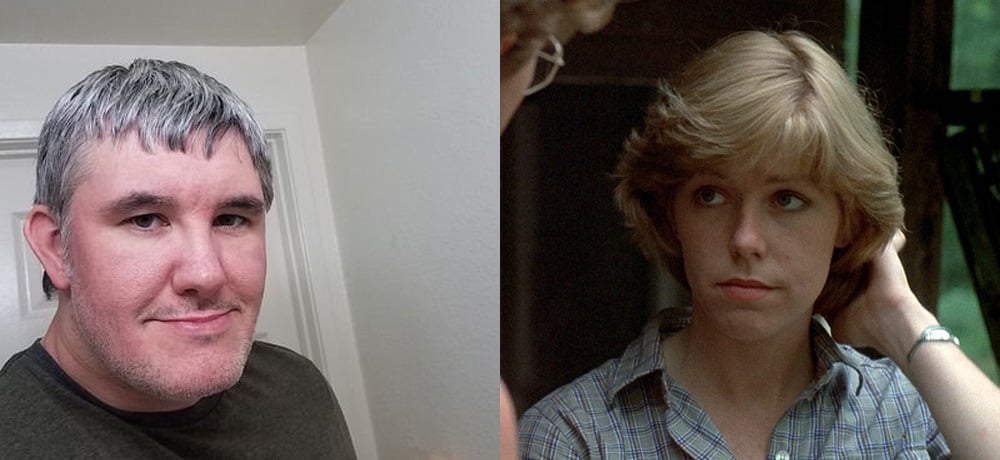
Brian Collins (Film Writer, Author)/Friday the 13th
I wasn't the first and I probably won't be the last to see Friday the 13th (1980) with preexisting knowledge of Jason Voorhees, the hockey-masked killer that will instantly come to mind whenever the title is uttered. As everyone except Casey Becker (RIP) knows, Jason didn't show up until Part 2—his "death" was what turned Mrs. Voorhees into a vengeful killer, wreaking havoc on Camp Crystal Lake until she met the business end of a machete. Because of the franchise's unusual origins, the first film often gets a bit of a shrug from some hardcore fans, who see the lack of Jason as a detriment—and to be fair, in retrospect it almost feels like a prequel film that someone might have come up with down the road ("Hey, what if we flash back and do a movie about Jason's crazy mother?").
But to write the film off is to deny yourself what is—Jason or not—a solid slasher film that boasts a charming cast, a terrific location (much scarier than other slasher camp locales, in my opinion), and, most importantly, Tom Savini's terrific FX, which would only grace one more entry in the series. It's also a creepier film than any of its sequels; the victims' familiarity with the offscreen killer lends it an uneasiness that the Jason-fied sequels could never manage, and the reduced cast and isolation from civilization keep things tense whether the deranged matriarch is stalking our heroes or not. Even after a dozen viewings (OK, probably two dozen) there's still something incredibly unsettling about Ned innocently wandering into the cabin (in the daytime!), as Sean Cunningham's camera remains outside to let us wonder what happened to him—as much as I enjoy the sequels, I wish they could have occasionally attempted more unnerving moments like this one.
Sure, the mystery is impossible to solve (Mrs. Voorhees is thrown into the movie so late, sans any prior mention, that she isn't even given a first name until one of the sequels) and the final chase goes on a bit too long, but laying the groundwork that would inspire a franchise that still remains popular 40 years later more than makes up for its lapses. Think of it as the trailers before the feature presentation—an essential and equally enjoyable part of the experience.
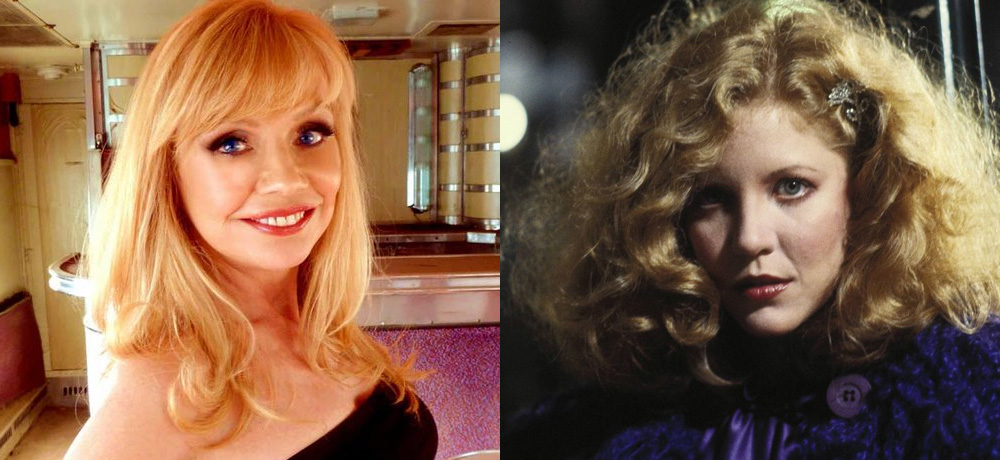
Kelli Maroney (Actress)/Dressed to Kill
I hadn't seen Dressed to Kill for years, and I was excited to watch it again because 1980 was such a vital time in film history. With Dressed to Kill, I felt like I was watching the ’70s and ’80s film styles morphing together before my very eyes.
Dressed to Kill is director Brian De Palma's love letter to Hitchcock in every way, right down to its mischievous humor. The film is mesmerizing, and every scene and every shot are an homage to the great Hitchcock. It's such a beautiful film that it's difficult to take one's eyes off it. There are even two, count ’em, two suspenseful shower scenes in Dressed to Kill, so Psycho obviously made a big impression on all of us, and rightly so.
The stellar cast—Michael Caine, Angie Dickinson, Nancy Allen, Dennis Franz—are all actors in top form and the truth in their performances is a nice juxtaposition to the sophisticated cinematography and elegant art direction. The story and plot are pretty thin, however. For a whodunit thriller, it's crystal clear whodunit almost right away. There are some common plot holes of the ’80s, too—fun and forgivable things like women showering in full makeup and not getting their hair wet. It was a chuckle when Angie Dickinson did it, but then later on when Nancy Allen ALSO pulls it off, it was highly entertaining. I blame the decade, not the actors, though. Dickinson has a body double that's probably barely 21, but that's just part of the fun of watching ’80s films.
Most notable is that, in 1980, the plot twist of revealing a transgender character as the killer was a big surprise. In 2020, not so much. Michael Caine is extraordinary in the role, and the writing and directing were on point, for the time. However, some have found the script offensive, that it equates being transgender with being a murderer and mentally ill. Putting on my ’80s time travel goggles for a minute, it seems to me the filmmakers were trying for a whodunit plot device that would throw the audience off-track about the murderer. It was a way to put Caine's character in disguise in what they thought was a clever way, with no intention of any disrespect.
I am not here to denigrate or defend either line of thought. What I will say that it is truly remarkable to me how far we've come in 30 years. And in the end, that's my biggest takeaway from Dressed to Kill.
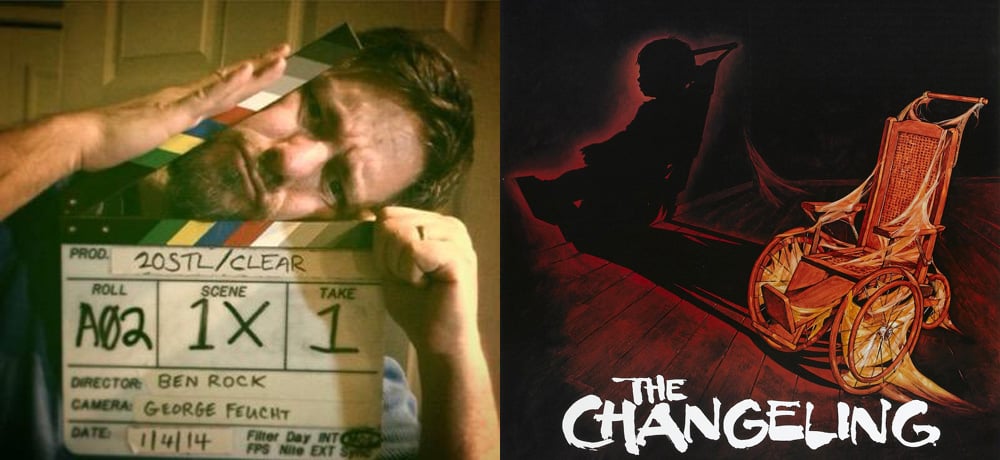
Ben Rock (Filmmaker, Theater Director)/The Changeling
In 1980, thick black boxes affixed to the telephone cables running through our neighborhood announced that cable television was finally being offered in rural Central Florida. My parents immediately subscribed to the full package. At the age of nine, I was already a fan of horror movies, but the black-and-white or edited-for-TV kind that ran on Tampa’s “Creature Feature,” hosted by Dr. Paul Bearer, which were less scary than intriguing to me at that age.
HBO stepped it up significantly, and as a family we decided to watch Alien, which we did until the chestburster scene, and my parents were so grossed out that they turned the movie off and I didn’t finish it until I was 16 and could rent it myself. But one night, left unattended in front of the TV, Peter Medak’s The Changeling came on HBO, and I watched it in its entirety by myself.
The empty house. The spider-webbed wheelchair. The whispers in the dark. The automatic writing. And the image that really stuck with me for whatever reason at the time: that ball bouncing down the stairs. After seeing The Changeling, I couldn’t sleep, forcing my mother to spend the whole night and into the morning trying to settle me. I gave in around 4:00am, and no movie has ever scared me that much since.
Days later, I was talking to my grandfather, a former Vaudevillian. I told him about how The Changeling had terrified me, and he chuckled. “You know, those movies are just made by a buncha people standing around in a warehouse or something, right?” I honestly didn’t know that at the time, but I agreed. He said, “Lemme ask you, you think those people makin’ that movie in that warehouse with all the lights and the whatever, were they scared while they were makin’ it?” I supposed not. The spell was broken. Without meaning to, he’d told me that regular people made movies.
---------
Visit our online hub to catch up on all of our Class of 1980 retrospectives!